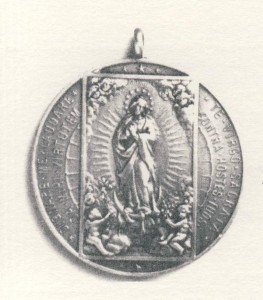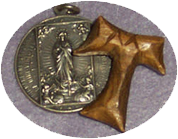Spirituality
Marian and Franciscan Spirit
Reflections on the Immaculate Conception
My soul magnifies the Lord And my spirit rejoices in God my Savior; Because He has regarded the lowliness of His handmaid; For behold, henceforth all generations shall call me blessed; Because He who is mighty has done great things for me, and holy is His name; And His mercy is from generation to generation on those who fear Him. He has shown might with His arm, He has scattered the proud in the conceit of their heart. He has put down the mighty from their thrones, and has exalted the lowly. He has filled the hungry with good things, and the rich He has sent away empty. He has given help to Israel, his servant, mindful of His mercy Even as he spoke to our fathers, to Abraham and to his posterity forever.
Jeanne Brolan, SMIC Associate
As I read these words, I can just vision this young Jewish girl studying the words of the Prophets. We know her family and her extended family were priestly people so she must have been well educated on the Old Testament. Mary's response to the angel tells us she is very familiar with Isaiah 43 because she knew how to respond to the angel of the Lord. Her heart must have been filled with the words of Isaiah for she understood to trust in the Lord without fear. She understood that she was indeed precious and glorious in God's eyes. She had the wisdom to know the power of her God and that no matter what was to come into her life and that of her child she would not be consumed by those events because God loved her, God called her by name. Her knowledge of the Old Testament gave her the courage not to be afraid.
I have often read these words that Mary spoke in her response to the angel and looked at them as her holy words. I saw a young girl being able to give this response because she already started out in this world as being without sin. I would read the Magnificat with the understanding that Mary was teaching us how to respond with a Yes to God's plan for her and for us. I would read it and pray that Mary would guide me and help me say yes but I did not look for anything else in Mary's response. I did not see any other connection. I only saw Mary was this very holy woman who had wisdom beyond human wisdom. Her words were for God.
Now I know this beautiful prayer is an example for us. It is not just in our "Yes" to God's plan for us but on how we must understand God's goodness and have faith that no matter what comes into our life, our God will protect us. Mary had studied the wisdom of the prophets so she knew the power of the Lord. This young woman is saying "Yes, Yes! Lord I will carry this child without fear." She is saying, "I don't know how my world will accept me with child but I let go of my concerns and trust in your ways." Her example is not just how to say yes but how to trust; she is showing us how to let go of fear and just know the power of the Lord will take care of every moment from the time the Yes is uttered.
In this one faith filled response Mary is giving us the tools for life. "My soul Magnifies the Lord, "Mary is telling us God is in us and we are in God. When we take time to contemplate of this "Awe" concept we can see how precious we are in the eyes of our God. Fear is such a big distress in our individual worlds. Mary is telling us how mighty God is, she is showing us how to let go and fully accept that our God will not let our troubles consume us, all we have to do is say Yes and let go of our fear. She is sharing with us how God sees us as we trust in His mercy. Mary is the living example of what the Isaiah writes about. If the only tools in life we had were Isaiah 43 and Mary's Magnificat we would have what we need to function very well as people of God
The Undying Allure of St. Clare of Assisi

Vatican City, 31 March 2012 (VIS) – Franciscans and Poor Clares throughout the world are currently celebrating the "Clarian Year", the eighth centenary of the "conversion" and consecration of St. Clare of Assisi (1193-1253) which took place on Palm Sunday 1211 or 1212. For the occasion, Benedict XVI has written a letter to Bishop Domenico Sorrentino of Assisi – Nocera Umbra – Gualdo Tadino, Italy.
The Pope recalls the life story of the founder of the Poor Clares. Following St. Francis' advice, she attended Palm Sunday Mass dressed in all her finery. She received a palm from the hands of the bishop then, later that night, fled the house of her parents – who had been hoping to marry her to a wealthy man – and went to the Porziuncola where St. Francis and his companions were waiting for her. There Clare renounced the world, Francis cut her hair and she adopted the black veil and rough sandals which became the first habit of the Poor Clares.
Clare's history "also speaks to our generation, and has a particular fascination for the young", the Holy Father says. Francis had a good reason for advising Clare to flee her parents' house at the beginning of Holy Week. "All Christian life, and thus also consecrated life", he writes, "is the fruit of the Paschal Mystery and of our participation in the death and resurrection of Christ. In the Palm Sunday liturgy pain and glory come together, a theme which will be developed over the following days through the dark night of the Passion up to the ultimate light of Easter. With her choice Clare relived this mystery".
"At its most profound level, Clare's 'conversion' is a conversion of love. No longer would she have the refined dress of the Assisan aristocracy, but an elegance of soul expressed in praise of God and giving of self. Day by day a fraternity came into being within the confines of the monastery of San Damiano, at the school of the Eucharistic Christ, … a fraternity regulated by love of God and prayer, by concern for others and service. It was in this context of profound faith and great humanity that Clare came to interpret the Franciscan ideal, imploring the 'privilege' of poverty and renouncing even the shared possession of material goods, something which left even the Supreme Pontiff perplexed, until in the end he too surrendered to the heroism of her sanctity".
The Holy Father continues: "How can we not present St. Clare, and St. Francis, to the young people of today? The time dividing us from these two saints has not lessened their allure. Quite the contrary, their contemporary importance is evident in the face of the illusions and delusions which often mark the life of modern youth. Never has a time caused the young to dream so much, with the multiple attractions of a life in which everything seems possible and permissible. And yet, how much dissatisfaction exists, how many times the search for happiness and self-realisation follows paths which lead to artificial paradises such as those of drugs and unbridled sensuality. And the current situation, with the difficulty of finding dignified work and forming a united and happy family, adds further clouds to the horizon.
"Yet", the Pope adds in conclusion, "there is no lack of young people who, even in our own times, accept the invitation to entrust themselves to Christ and to face the journey of life courageously, responsibly and hopefully, choosing even to leave everything to follow Him and serve their brethren. The story of Clare, with that of Francis, is an invitation to reflect upon the meaning of life and to seek the secret of true joy in God. It is concrete proof that those who accomplish the will of God and trust in Him not only lose nothing, but discover the real treasure which gives meaning to everything".
Ronald L. Pihokker, M.A. Ed.
Director
Catechetical Office – Archdiocese of Newark
(973) 497-4291 pihokkro@rcan.org
Congregational Medal
Prayer to the Apocalytic Virgin on our Medal

Dignare me laudare te Virgo Sacrata
Da mihi virtutem contra hostes tuos
This prayer is attributed to John Duns Scotus (1262-1308) the great Franciscan "Marian Doctor" when, at the request of Pope Clemens V, he was to appear at the Sorbonne University in Paris to defend before an august assembly of Cardinals and theologians his theory that Mary was conceived without sin. Legend has it that on his way to the University, he repeated the prayer again and again.
At least from 1924-1929, this prayer was said daily in Latin at the beginning of Morning Prayer.
From 1929, the prayer was said in English before the Tota Pulchra every Saturday after Vespers.
Great that I may praise thee, O' Sacred Virgin
Give me strength against thine enemies
The SMIC Medal was crafted from the medal at a shrine in Germany called Our Lady of Neviges.
The medal shows Mary , spared from sin, irradiated with light. The is the woman of the the Revelation about whom we read: "A woman, adorned with the sun, standing on the moon and with the twelve stars on her head for a crown." With God's grace she conquered the serpent, the evil one. He lied dead at her feet.
In each of us there lives an indelible image of the fully redeemed person. Mary tells us that in Christ this hope is possible. Also note that the light is not her own, but the light of her son whom God gave to her. The angels at her feet bring lilies and roses, the gifts of a creation freed from sin and death.
Thus Mary, illuminated by the light of Christ, becomes for us the star of the sea which helps us to find our way through life to the morning star, who announces the sun and points towards our sole Redeemer, Jesus Christ.
Reflection by Fr. Alexander Gerken, OFM

